Sarah Ward
"In the summer evenings there were so many moths and bugs, you had to put the window wipers on to clean the windscreen.
As a child we would always check the cattle grate to make sure a hedgehog hadn't fallen down one and become trapped. I would see hedgehogs all the time.
I still live in the countryside and have not seen a hedgehog for years. My 13 year old son has never seen a hedgehog in the wild."
Your memories of a wilder Suffolk
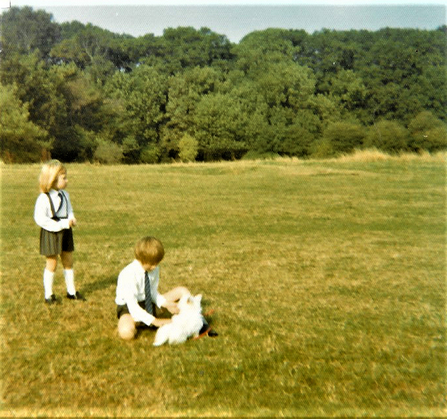
Susan Stone with her brother and dog Bilbo in circa 1973, outside their back garden with scrub and Felixstowe Grove in the background.
Susan Stone - Felixstowe
"During our childhood in Felixstowe (late 60’s and 70’s), my brother, our dog and I could walk to the Grove, the ‘Wildwood’ and Gulpher pond without crossing a road.
Heading out of the back-garden gate through the privet hedge, across the old Eastward Ho! golf links and horse paddocks we often visited the spring-fed pond.
Every spring we watched tadpoles clambering in the shallows, accompanied by the buzzing of bees visiting the pussy willow and blackthorn surrounding the pond.
Between the pond and the Grove, a dense blackthorn thicket, its white blossom billowed like a cloud from the woodland edge. I don’t remember ever hearing nightingale singing in the thicket, but I do remember my dad listening for them on a moonlit night - the glorious sharp scent of cold spring night air coming in through the open window.
By day, I loved to see the Robin singing from the blackthorn tops – its chest puffed out like the shape of the thicket itself and the red colour matching the inside of the blackthorn flowers.
A narrow ‘natural’ tunnel led through the scrub into the Grove. At first this woodland is broad enough that you can’t see the edges, with a network of paths through understorey of holly and bramble. On past the ‘flush’ where the kingcups flower, following the stream, the woodland tapers to a narrow ribbon, petering out completely just before Gulpher Road.
Many years ago, part of the old golf links were given over to a car park and the rough grass around the scrub and pond more regularly mown as part of the neighbouring recreation and sports fields
But the Grove, the ‘Wildwood’, the thicket and the spring fed pond are all still there and remain a much used and loved area for people to walk and connect with nature on their doorstep.
So, there is still the chance to rekindle, reconnect and retain these habitats that I remember and for them to create memories for others in the future."
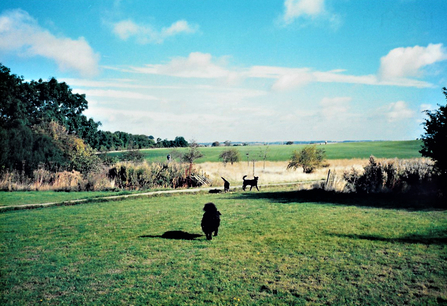
Eastward Ho, Felixstowe in 1989 after the conversion of arable fields to recreation area and sports pitches. The spring fed pond is in the scrub to the right.
Gary Kenworthy
"I remember the many orchards full of apples and being able to pick your own apples and pears. These fruit trees would be full of birds, bees and butterflies.
I remember many more finches in the garden – greenfinches and chaffinches. Also, the abundance of insects in the urban back garden – the beetles and earwigs in abundance.
I remember listening to and watching the many skylarks in the adjoining field.
I remember watching the tractor and combine harvester in the next field.
All gone!"
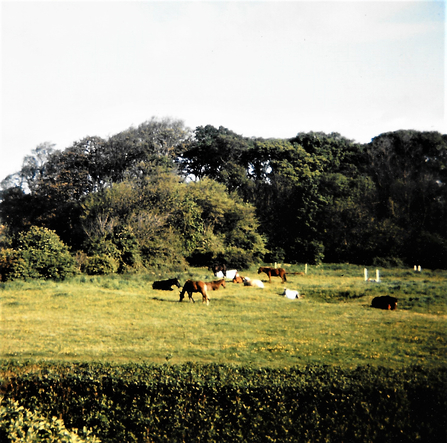
The old golf links in Felixstowe with the Grove at the back - in 1970's.
Miss Salmon
"Memories from the early 1960’s: Space, space and more space!
Dad was trying to teach Mum to drive. During the summer of 1964 Dad would pile us all into his car – a lovely white Zephyr – and drive off to the disused Ellough Airfield, near Beccles. When he opened the doors we would all race out and run, run and run! The space and freedom available to us all was intoxicating!
The old white concrete area was enormous, surrounded on all sides by high summer grasses, a plethora of an assortment of flowers and colourful weeds. We spent ages chasing butterflies, dragonflies and pond-dipping in the broken concrete surfaces.
We stopped only for jam sandwiches and squash then we’d be off again; free and safe.
It was an enchanting, peaceful place and a haven for nature. I am in my late 60’s now and I can still summon up the lovely memories of that particular summer and am so grateful that I and my siblings had such access. Good old Suffolk, always something around the corner!"
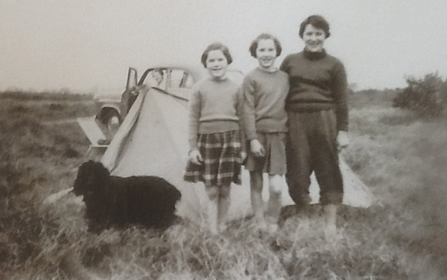
Jill, Linda and Susan Harris camping in Suffolk in the 1950's
Tony Radford
"Getting towards dusk in May, walking on Westleton Heath trying to see nightjars. Heard plenty, tried to track one down and see it but no joy. Started walking towards Dunwich down the old Roman road track. Passing a large hawthorn bush I heard the most beautiful burst of nightingale song. I stood, transfixed by what felt like a personalised recital. Tried to see the performer but it was too dark. No matter, but that ten minutes of wondrous music will live with me forever."
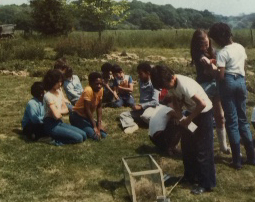
Lesley Cattling in Suffolk in the 1970's
Alan Cordy
"Growing up on a Suffolk pig and mixed farm in the 1960's, I was surrounded by wildlife. The buildings were always alive with the happy chatter of the sparrows from their scruffy straw nests in the rafters of the buildings.
Spring welcomed the swallows and house martins, swooping low over the ponds scooping up insects and water in their amazing aerial aerobatics. Clouds of flies from the muck heaps supplied constant food for all, pied wagtails with tails bobbing running and darting to catch their quarry.
Outside the grain store on the dropped grain, clouds of sparrows, yellowhammers, green finches and starlings bustled to get best pickings.
In spring the scent of the acres of apple orchard filled the air, and was alive with bull finches and chaffinches, that's not to say they were not trapped to stop them feeding on the swelling buds, but were released by me if able to find the traps. In the autumn huge mushrooms appeared, the size of tennis balls, growing large enough to fill a frying pan.
Lapwings nested in the grass below the trees, hares boxed, and rabbits bobtailed in and out of the hedgerows. The Spring call of the cuckoo sadly not heard now for the past three years.
In Autumn ploughing heralded seagulls following the plough like surf breaking in the crest of a wave over the clods, their seaside calls 50 miles inland.
Visiting my grandparents at the weekend in a nearby village brought its own memories, the tap tap tap of the thrush breaking snail shells on the concrete path beneath my bedroom window, the crunch of their shells as you walked on the path.
House martins with beaks of wet mud building nests under the eaves of the house, my nana trying to knock them down with a broom, 'they make a mess' she said. Glad to say she didn't get them all. At dusk under the newly installed roadside light the moths gathered, bats doing aerobatics darting and swooping in order to catch them. Our car journey home was always in a moth snowstorm, their small bodies trapped in the radiator of the car the following morning.
How lucky am I to have these memories, how sad that they have become just that, memories."
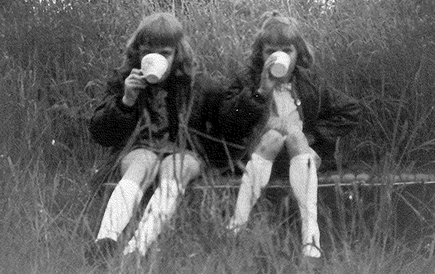
Sally and Jenny Hardwick in Suffolk in the 1960's
Mrs Buffham
"I was brought up on farms in Suffolk and can remember hearing owls hooting at night and foxes barking. In the spring cuckoos would call to each other.
There were hoards of different species of butterflies, bees constantly buzzing and flies being a nuisance.
In the lanes, there were sweet smelling violets and primroses and ‘poggles’ (cowslips) growing on the banks.
We also fished for tadpoles and newts and other invertebrates in our pond."
Jenny Vanderhook
I lived at Ashbocking from 1948 to 1963 and ran barn Grove Farm from 1953 to 1963 when I got married. I remember the farm opposite had a meadow full of wild flowers where the farm cart horse was kept when it wasn’t working. One day, about 1952, I came home from school (Ipswich High) to find the horse gone and the meadow ploughed up. At the time I reckoned I could name every wild flower that grew in Suffolk and I knew exactly where there was a clump of bee orchids in that meadow. I clearly remember being very cross and that was the start of my being what is now known as a conservationist.
Margaret Rishbeth
In the mid-70s I used to visit a friend in Dunwich quite often and on the road between Dunwich and Westleton – where the road to Minsmere goes off, there were corn marigolds in the arable crops – soon to disappear after a few years. Very sad.
Also, in my friend’s garden, overlooking the marsh, she had weasel snout (Misopates orontium) growing...
S Harrup
I remember the field of poppies on the left as you went up Ballingdon Hill... I remember carrying our twin toddlers in their pushchairs across fields to visit Chilton Church!
I remember returning to Sudbury after dark and seeing a small spread of lights at the bottom of the hill. Now the lights spread to the horizon.
There were green slopes where folk walked their dogs, now there are houses and the Upper School. Lots of ‘in-filling’ of small spaces in the town as well as expansion for homes and industry. BUT we all live on once ‘green spaces’.
L Spring
Fox cubs and weasels playing on what is now a housing estate. House martins nesting under the eaves of our cottage.
Janis Bear
In our small market town of Sudbury in the 1960s – 70s we hadchalk pits which housed thousands and thousands of sand martins before they were filled in.
We had ponds scattered around Suffolk that also had thousands and thousands of great crested newts that you could scoop up by the bucket loads. Also grass snakes in ponds.
Everywhere was alive with the chirping of sparrows. Green finches everywhere which we hardly see now. Masses of butterflies, lapwings and song thrushes. Insects everywhere. Poppies in cornfields. Open barns full of chattering sparrows eating grain. Ponds full of frogs and spawn. The sky was full of swifts, swallows, house martins. Summer in Suffolk was full of their screaming through the sky. Sadly most of this beauty of my childhood has gone.
G Oram
My family came from Leicestershire to farm in north east Suffolk in 1946 before words like ‘wildlife’ and ‘habitat’ became common. In fact, if you used those words then you might be considered a bit weird! Wild creatures were just there. I’m afraid we took everything rather for granted. I was more interested in shooting the right birds rather than watching them. (I don’t now).
Memories fade but I do remember the nightingale which sang from a thicket near the horse pond, partridges calling before settling down to sleep and near the coast, red-backed shrikes on the wires and barn owls hunting round the corn stacks.
V Hems
Billy witches in May in Rushmere (cockchafer beetles)
Hundreds of lapwings on fields near Hintlesham.
Mallard ducks with large broods on pond in Rushmere.
Yellowhammers in hedgerows.
Hedgehog road kill.
Bullfinches in garden.
Sarah Watts
I remember the cold winters when the River Orwell froze and my mother feeding porridge oats to the swans from the smoke room window of the Butt & Oyster, Pinmill.
At low tide the saltings would be alive with wading birds.
Tawny owls calling in the trees and house martins nesting under the gable end eaves. There were stag beetles in Pinmill Lane and a barn owl would quarter the fields.
Alec Bull
Imagine two four-acre meadows white with ox eye daisies and with purple knapweed, pink restharrow, yellow rattle and above all, hundreds of fragrant orchids.
One of the two, sheltered from the north by a wood full of oxlips, also had early purple and spotted orchids, twayblades, the occasional bee orchid and a small colony of frog orchids.
All ploughed up in 1949. During the depressions 15-18 years earlier with land selling for £5 per acre it would have been possible to buy both meadows for £40!
K Dunlop
I remember lots more butterflies and moths in the gardens, more bird song in the morning. Saw my first bittern by the Waveney in Bungay. Lots more earth worms and slow worms (only seen 1 in 2 years!). Grass snakes were pretty common. Brown owls in woodland and more red deer roaming the countryside. I think concrete driveways and car parks and loss of wild over-grown areas are tragic. Hedgehogs were more common too but now fenced out of everyone’s gardens. I used to feed red squirrels on way to school!
M Thistlethwaite
A baby cuckoo atop a gatepost being fed by its hapless dunnock ‘mother’.
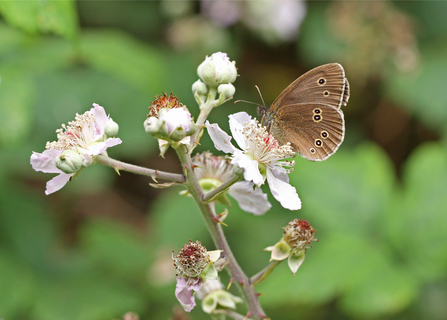
Ringlet butterfly by Steve Aylward
Ringlet butterfly by Steve Aylward
Mr & Mrs Gill
Paddling in the old Gipping Lock at Bramford Mill, among thousands of elvers heading downstream.
Catching sticklebacks and great crested newts in the pond at the end of 'the grove' off Henley Road (now under housing).
When living near Butley Mill - nightingales, marsh harriers, snipe 'drumming' in summer.
Clouds of cinnabar moths rising from fields of ragwort on the Brecks.
